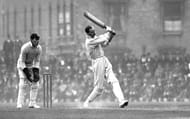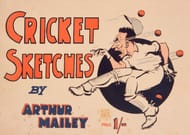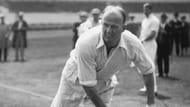
At a time when a plethora of mid-career autobiographies (mostly ghost-written) hit the market every year, we mustn't forget about the cricketers who really wrote well and, more importantly, didn't require a ghostwriter to do the job for them.
Raymond Robertson-Glasgow and Peter Roebuck were not the greatest cricketers but they were first-class writers. Robertson-Glasgow's pen portraits of cricketers he played with and against are possibly the best short pieces on cricketers.
On the other hand, Roebuck's description of a season in the life of an ordinary county cricketer in 'It Never Rains' makes it among the best books of that genre. However, there were famous and successful cricketers who did write well. Here is a look at five of them:
#5 Bill Bowes
Bill Bowes was an accurate medium pace bowler who played for England on 15 occasions. He was part of the England team in three Ashes series: 1932-33, 1934 and 1938. He was initially not a part of the team for the 1932-33 series and received his invitation only a few days before the team set off for Australia.
In a decade when a lot of runs were made in Ashes Test matches he picked up a lot of wickets for cheap.
Bowes came back for a post-war Test against India but by then he was clearly past his best. He was a very popular cricketer and his benefit in 1947 fetched him a then-record 8000 GBP.
He was a sound judge of the game and, post retirement, did not waste any time in nurturing that skill. He wrote an excellent autobiography in 1949, naming it 'Express Deliveries'.
He also contributed to many of the well-known newspapers in England. A regular contributor for Wisden, he often wrote thought-provoking pieces on his favourite subject, Yorkshire cricket.
He later wrote a book on the 1961 Ashes series and called it 'Aussies and Ashes'. His career as a writer and journalist spanned more than four decades.
#4 Percy Fender

Fender has often been regarded as the shrewdest captain not to have led England in Test cricket. He led Surrey with distinction but didn't lead his country in any of the 13 Test matches he played. He was a hard-hitting batsman who once scored a First-class century in 35 minutes.
A useful bowler as well, he picked up two five-wicket hauls in the 5 Ashes Tests he played. Three of them were in Australia and the other two in England. He was unfortunate to face one of the strongest sides in Test history and his performance, apart from those two five-wicket hauls, was ordinary.
But Fender's contribution didn't end there. He was known for his understanding of the game and was consulted by Jardine before the latter developed tactics for the infamous Bodyline series.
Fender was a fine writer. His tour books are among the best written on the game.
Fender was a colorful and important character in English cricket and deserved a biography but it was a long time coming. In 1981, a year before his death, Richard Streeton of The Times finally filled that void.
Here is a list of must-read books by Percy Fender:
Defending the Ashes, concerning the 1920-21 Ashes series
The Turn of the Wheel, concerning the 1928-29 Ashes series
The Tests of 1930, concerning the 1930 Ashes series
Kissing the Rod, concerning the 1934 Ashes series
#3 Arthur Mailey

Arthur Mailey bowled leg-breaks, googlies and long-hops and always saw the funny side of almost everything that happened on the field of play. He took 99 wickets in Tests, with 36 of them coming against England in the 1920-21 Ashes series. He once took all 10 wickets (for 66 runs) in an innings in a First class match, against Gloucestershire at Cheltenham.
During one of the matches against England, he entered into a pact with team-mate Jack Gregory during the lunch interval. The idea was that his first ball to Hobbs in the second over would be a googly pitched on middle and leg stump. Gregory was to spring around the back of wicket-keeper Oldfield and wait at leg-slip for the catch.
Gregory remembered the plan but Mailey himself forgot about it. He bowled a perfect leg-break and realized the blunder when he saw Gregory moving towards leg-slip. Gregory though somehow managed to remain composed and leaped to his right to take a catch at slip.
After retirement, he traveled with the Australian team to many countries to cover matches for newspapers. He was an able cartoonist and books containing his sketches have become collectors' items at auctions all over the world.
He covered the Bodyline series extensively and wrote a very detailed account in his book titled 'And Then Came Larwood'.
In 1958, he wrote an autobiography and called it '10 for 66 and all that'. It is one of the finest autobiographies written by a Test cricketer.
#2 Bill O'Reilly

O'Reilly, despite being a spinner, had a temperament that matched the fast bowlers. In his classic book 'Between Wickets', Ray Robinson narrated an incident which supported this view.
"Before entering the field in one Test he said to Hele, Australia's leading umpire, 'How's your sight today, George?' Hele said his eyes were good. 'Hearing all right too?', asked O'Reilly. Hele said there was nothing wrong with his hearing. 'Good,' said O'Reilly. 'You'll need 'em today because I'm going to get among these so-and-sos.'"
O'Reilly was a teacher and made sure his students learnt the game in the right way. They, in turn, were proud of their teacher. In 1938, after he skittled England twice to win the Headingley Test, his students sent him a cable which read: "Satisfactory - a trier."
O'Reilly had strong opinions on everything related to cricket. He was a staunch protester of limited-overs cricket. He wrote two Ashes tour books - one on the 1948 Ashes series and the other one on the 1950-51 Ashes series.
Jack Fingleton

He was a fine writer who analyzed the game better than most. Yet, it was always his dislike for Bradman that got highlighted. He himself did the damage, though.
Fingleton once scored four centuries in consecutive innings, the final one being in an Ashes Test against England in Brisbane. Later in that series in 1936-37, he scored another century in Melbourne. But his career was virtually over by the time he entered his 30s and the war that followed ensured he never returned.
Fingleton left the war to come back home to meet his wife. However, he was again sent on duty, this time to Queensland, where he decided to write a book. Its publication coincided with Ray Robinson's 'Between Wickets' but, rather surprisingly, both books did exceedingly well. 'Cricket Crisis' is now regarded by many as one of the finest books in the history of cricket literature.
Fingleton went on to write many more books. His tour books on some of the Ashes series played in the 1950s are highly acclaimed. He wrote an autobiography as well and is often regarded as the finest writer among Test cricketers.
Follow IPL Auction 2025 Live Updates, News & Biddings at Sportskeeda. Get the fastest updates on Mega-Auction and cricket news
